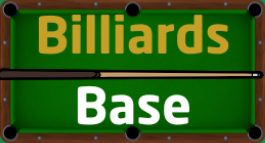Pool balls form the essential core of every billiards game, yet many players underestimate how dramatically ball quality affects gameplay experience, shot accuracy, and long-term enjoyment. Unlike other equipment where mediocre quality might be tolerable, substandard pool balls create frustrating inconsistencies in roll patterns, durability issues, and poor aesthetic appeal that diminishes the entire playing experience.
Whether you’re setting up your first home table, replacing a worn set, or upgrading from basic balls to professional quality, understanding the differences in size specifications, materials, and brand characteristics is crucial for making informed decisions. The wrong ball set can make even excellent tables play poorly, while quality balls enhance every aspect of your game from break shots to delicate positioning.
Pool Ball Sizes Explained
Standard American Pool Ball Size
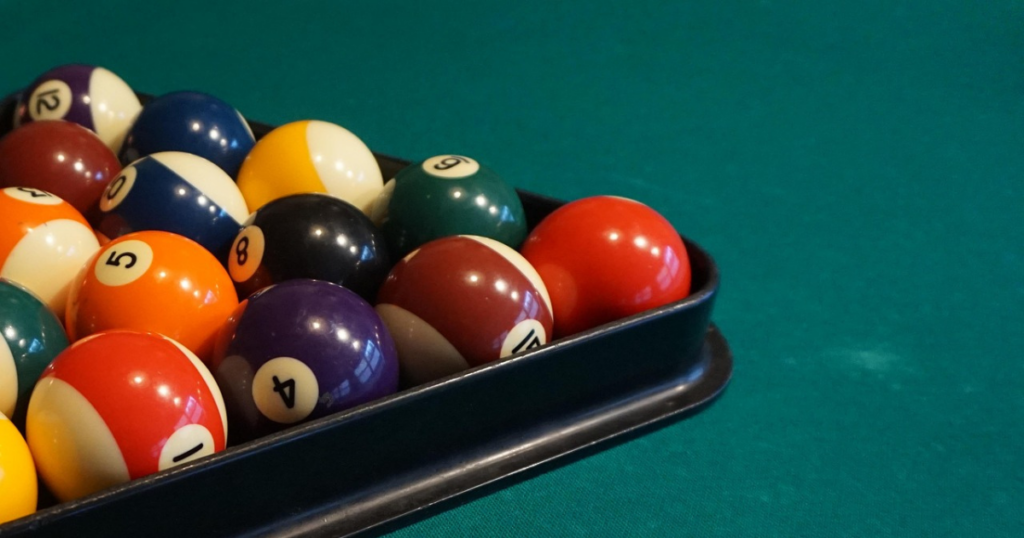
Regulation Specifications:
- Diameter: 2.25 inches (57.15mm)
- Weight: 5.5-6.0 oz (156-170g) per ball
- Tolerance: ±0.005 inches for professional sets
- Usage: Standard for all American pool games (8-ball, 9-ball, 10-ball, straight pool)
When American Size Is Used:
- Home tables 7-foot, 8-foot, and 9-foot sizes
- All tournament play in North America
- Professional leagues and competitions
- Bar and commercial pool tables
- Most pool tables manufactured for the American market
English Pool Ball Sizes
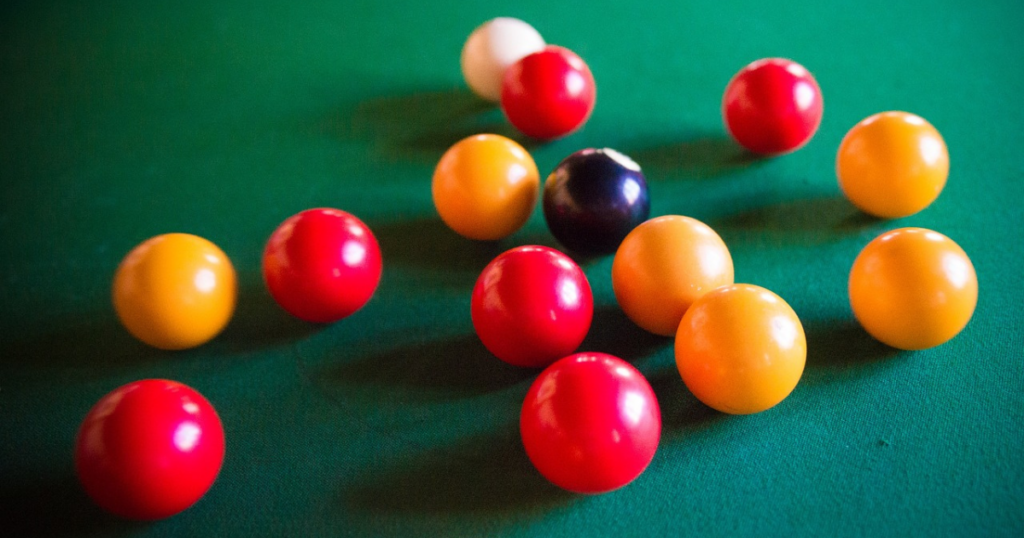
2-Inch English Pool Balls:
- Diameter: 2.00 inches (50.8mm)
- Weight: Approximately 4.5-5.0 oz (127-142g)
- Usage: Traditional English pool, some 6-foot and 7-foot tables
- Regional preference: UK pub games, some European venues
1⅞-Inch English Pool Balls:
- Diameter: 1.875 inches (47.6mm)
- Weight: Approximately 3.5-4.0 oz (99-113g)
- Usage: Smaller English pool tables, youth tables
- Applications: Space-constrained installations, junior leagues
Size Impact on Gameplay
Ball-to-Pocket Ratio Effects:
- American balls (2.25″): Designed for 4.5-inch pockets (2:1 ratio)
- English balls (2.0″): Suited for 3.5-inch pockets on English tables
- Compatibility issues: Using wrong size affects difficulty and strategy
Table Compatibility Considerations:
- Pocket clearance: Proper ball-to-pocket ratio ensures optimal challenge level
- Playing surface: Ball size affects how balls interact with cushions and felt
- Cue ball control: Size impacts spin transfer and positional play precision
- Break patterns: Ball mass and size significantly affect break shot dynamics
Performance Differences by Size:
| Ball Size | Best For | Pocket Difficulty | Break Power | Precision Shots |
| 2.25″ (American) | Full-size American tables | Moderate | Maximum | Good |
| 2.0″ (English) | English pool tables | Higher | Moderate | Better |
| 1⅞” (Small English) | Compact tables | Highest | Lower | Best |
Materials Used in Pool Balls
Historical Context
Ivory Era (1600s-1970s):
- Material: Elephant tusk ivory carved into spherical shapes
- Advantages: Excellent density, smooth surface, superior playing characteristics
- Disadvantages: Expensive, environmental concerns, inconsistent availability
- Legacy: Set the standard for modern synthetic materials to match
Early Synthetic Attempts:
- Celluloid (early 1900s): First plastic alternative, highly flammable
- Bakelite (1920s-1940s): Improved durability but limited color options
- Early resins (1950s-1960s): Better colors but inconsistent quality
Modern Material Standards
Phenolic Resin (Premium Standard):
Composition and Properties:
- Material: Thermoset polymer created through controlled chemical reaction
- Density: Closely matches original ivory for authentic feel
- Hardness: Optimal surface hardness for consistent ball action
- Color stability: Fade-resistant pigments integrated throughout material
Performance Characteristics:
- Ball-to-ball consistency: Minimal weight and size variations
- Roll accuracy: Perfectly spherical shape and balanced weight distribution
- Durability: Resistant to chipping, cracking, and surface wear
- Sound quality: Crisp, clear contact sound during ball collisions
- Temperature stability: Minimal expansion/contraction with climate changes
Professional Applications:
- Required for all major tournament play
- Standard for high-end pool tables and serious players
- Preferred by professionals for practice and competition
- Investment-grade quality with excellent longevity
Polyester Resin (Mid-Range Option):
Construction Details:
- Material: Less expensive thermoplastic polymer
- Manufacturing: Injection molded for consistent basic specifications
- Quality range: Varies significantly between manufacturers
Performance Comparison:
- Playability: Adequate for recreational and learning purposes
- Durability: Good for moderate use, less resistant to heavy play
- Consistency: Acceptable weight distribution, occasional variations
- Sound: Slightly different contact sound compared to phenolic
- Longevity: 3-5 years with regular home use vs. 10+ years for phenolic
Acrylic and Budget Materials:
Low-Cost Construction:
- Materials: Basic plastic polymers with lower density
- Manufacturing: Often with visible seam lines or surface imperfections
- Quality control: Minimal standards, significant ball-to-ball variations
Performance Limitations:
- Inconsistent roll: Weight and balance variations affect ball tracking
- Poor durability: Chips, cracks, and surface wear develop quickly
- Color issues: Fading, discoloration, and poor number visibility
- Short lifespan: Often need replacement within 1-2 years
Material Impact on Gameplay
Spin and English Application:
- Phenolic resin: Optimal cue ball response to spin application
- Lower-grade materials: Unpredictable spin retention and transfer
- Surface texture: Affects chalk interaction and tip contact consistency
Break Shot Performance:
- Density consistency: Uniform materials provide predictable break patterns
- Impact resistance: Quality materials withstand powerful break shots
- Energy transfer: Proper material density optimizes ball-to-ball collisions
Types of Pool Ball Sets
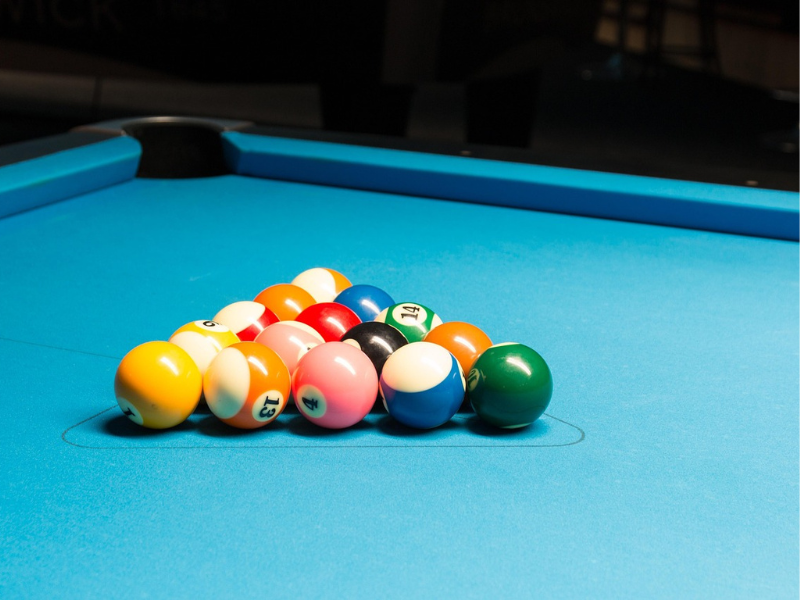
Standard Sets
Complete 16-Ball American Sets:
- Composition: 15 numbered balls (1-15) plus cue ball
- Organization: Balls 1-8 (solids), balls 9-15 (stripes), white cue ball
- Games supported: 8-ball, 9-ball, 10-ball, straight pool, rotation games
- Color coding: Standardized colors for consistent game recognition
9-Ball Tournament Sets:
- Composition: Balls numbered 1-9 plus cue ball (10 balls total)
- Usage: Dedicated 9-ball play, tournament specifications
- Advantages: Lighter set, focused on specific game requirements
- Quality: Often higher-end since used for competitive play
English Pool Sets:
- Reds and Yellows: 7 red balls, 7 yellow balls, black ball, white cue ball
- Color significance: Group identification rather than numbered system
- Size variations: Available in 2-inch and 1⅞-inch specifications
- Regional preference: Standard throughout UK and some European countries
Specialty and Training Sets
Training Ball Options:
Marked Cue Balls:
- Dot patterns: 6-dot arrangements showing ball rotation clearly
- Line markings: Equatorial and meridian lines for contact point visualization
- Numbered zones: Sections marked for spin placement training
- Dual-colored balls: Help understand ball rotation during shots
Ghost Ball Training Sets:
- Purpose: Visualization aids for target ball contact points
- Design: Translucent or specially marked balls showing contact areas
- Skill development: Helps players understand aiming systems
- Progressive learning: Builds fundamentals before advancing to standard balls
Instructional Ball Sets:
- Educational markings: Arrows, contact points, or instructional graphics
- Coaching tools: Designed for teaching proper technique and strategy
- Video analysis: Enhanced visibility for recording and reviewing techniques
- Skill building: Systematic approach to developing consistent mechanics
Decorative and Customized Sets
Novelty and Collector Sets:
- Artistic designs: Custom graphics, team logos, or personalized themes
- Historical reproductions: Vintage-style designs and color schemes
- Luxury materials: Premium finishes, special packaging, limited editions
- Gift applications: Special occasions, personalized presents, commemorative sets
Custom and Corporate Sets:
- Logo integration: Business branding, team identification, promotional use
- Color customization: Non-standard colors for specific aesthetic preferences
- Personalization: Names, dates, or special messages incorporated into design
- Quality considerations: Custom doesn’t always mean compromised playability
Collector Considerations:
- Playability vs. decoration: Balance between functionality and appearance
- Investment value: Some limited editions appreciate over time
- Display options: Presentation cases and storage solutions
- Authenticity: Verification for valuable or rare sets
Leading Pool Ball Brands & Pros/Cons
Aramith (Premium Standard)
Company Background:
- Origin: Belgian manufacturer with 130+ years experience
- Specialization: Exclusively focused on billiard ball production
- Market position: Gold standard for professional tournaments worldwide
- Technology: Proprietary phenolic resin formulation and manufacturing process
Product Characteristics:
- Material quality: Highest-grade phenolic resin with superior density
- Manufacturing precision: ±0.005-inch tolerance, perfect spherical shape
- Color vibrancy: Fade-resistant colors throughout ball, not just surface coating
- Durability: Industry-leading longevity with proper care
- Sound signature: Distinctive clear, crisp ball contact sound
Professional Recognition:
- Tournament standard: Used in World Pool Championships, Mosconi Cup, US Open
- Player endorsements: Preferred by virtually all professional players
- Quality certifications: Meets or exceeds all international tournament specifications
- Warranty coverage: Extensive warranty reflecting manufacturer confidence
Price and Value:
- Price range: $150-$300+ for complete sets depending on series
- Value proposition: Higher upfront cost offset by exceptional longevity
- Series options: Tournament, Crown, Super Pro, and specialty collections
- Investment grade: Maintains value and performance over decades
Cyclop (Tournament Alternative)
Market Position:
- Usage: Selected tournaments and professional events
- Design focus: Unique aesthetic approach with performance emphasis
- Innovation: Alternative manufacturing techniques and materials
- Recognition: Growing acceptance in competitive circles
Distinctive Features:
- Aesthetic design: Different color schemes and visual approaches
- Manufacturing: Alternative production methods to Aramith
- Performance characteristics: Comparable playability to other premium brands
- Availability: More limited distribution than mainstream brands
Considerations:
- Price competitiveness: Often positioned between premium and mid-range options
- Tournament acceptance: Verify compatibility for competitive play
- Long-term performance: Less historical data than established brands
- Support and availability: May have limited replacement/service options
Generic and Budget Brands
Quality Indicators to Evaluate:
Positive Signs:
- Material specifications: Clear identification of phenolic resin construction
- Manufacturing standards: Stated tolerances and quality control measures
- Warranty coverage: Meaningful warranty periods and terms
- User reviews: Consistent positive feedback from actual users
- Brand reputation: Established manufacturer with billiards focus
Warning Signs of Inferior Quality:
- Vague material descriptions: “High-quality plastic” without specifics
- No tolerance specifications: Absence of manufacturing precision standards
- Extremely low prices: Below $50 for complete sets often indicates poor quality
- Poor packaging: Cheap presentation often reflects overall quality approach
- Limited information: Insufficient product details or specifications
Budget Brand Evaluation:
| Quality Factor | Good Budget Brands | Poor Budget Brands |
| Material | Specified polyester resin | “Plastic” or unspecified |
| Weight consistency | ±2-3 grams variation | ±5+ grams variation |
| Color quality | Solid, fade-resistant | Fading, streaking |
| Price range | $75-$150 | Under $50 |
| Warranty | 6-12 months | None or very limited |
| User reviews | Generally positive | Frequent complaints |
How to Choose the Right Pool Ball Set for Your Needs
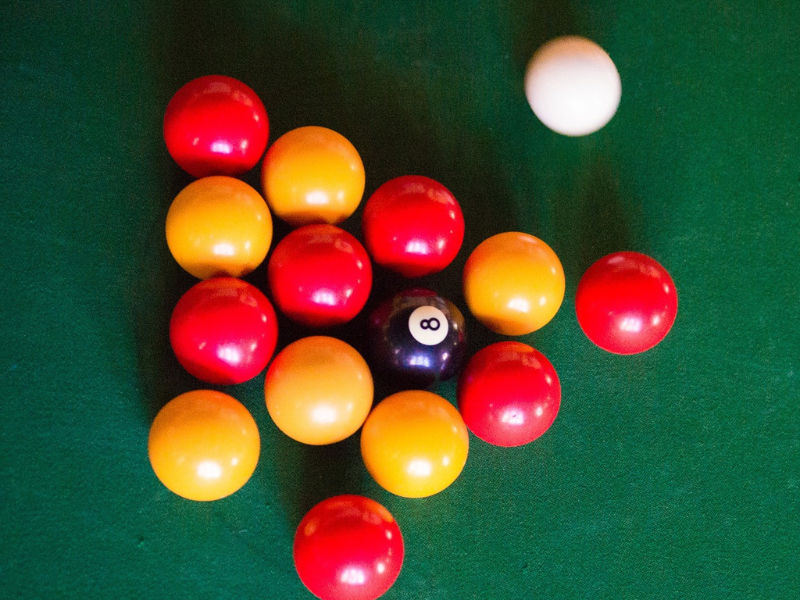
Step 1: Know Your Table Size and Game Type
Table Compatibility Assessment:
- Measure pocket dimensions: Verify appropriate ball-to-pocket ratio
- Confirm table origin: American vs. English/European specifications
- Check manufacturer recommendations: Table makers often specify optimal ball sizes
- Consider playing surface: Ensure balls complement felt and cushion characteristics
Game Type Determination:
- Primary games played: 8-ball, 9-ball, straight pool, English pool
- Player skill levels: Beginners vs. advanced players have different needs
- Playing frequency: Daily use vs. occasional entertainment
- Competitive aspirations: Tournament play requires regulation specifications
Step 2: Set Budget and Understand Value Propositions
Budget Categories and Expectations:
Premium Investment ($150-$300+):
- Brands: Aramith Tournament, Super Pro, Crown series
- Expected lifespan: 10-20+ years with proper care
- Performance: Tournament-quality consistency and durability
- Best for: Serious players, frequent use, long-term investment
Mid-Range Quality ($75-$150):
- Materials: Quality polyester resin or entry-level phenolic
- Expected lifespan: 3-5 years with regular use
- Performance: Good recreational play quality
- Best for: Home tables, casual to moderate players
Budget Options ($30-$75):
- Materials: Basic polymer construction
- Expected lifespan: 1-2 years with moderate use
- Performance: Adequate for learning and casual play
- Best for: Children’s tables, temporary setups, very casual use
Step 3: Material and Brand Considerations
Material Selection Priority:
- Playing frequency: Heavy use demands phenolic resin durability
- Skill level: Advanced players notice material quality differences more
- Table quality: Premium tables deserve premium balls
- Budget constraints: Balance quality with realistic spending limits
- Long-term plans: Consider upgrade timeline and usage evolution
Brand Selection Factors:
- Reputation and longevity: Established brands typically offer better consistency
- Availability: Local support and replacement availability
- Warranty coverage: Meaningful protection for investment
- User reviews: Real-world experience from similar users
- Professional acceptance: Tournament usage indicates quality standards
Step 4: Quality Assessment Criteria
Visual and Physical Inspection:
Essential Quality Checks:
- Color vibrancy: Numbers should be clear and colors vivid throughout
- Surface finish: Smooth, consistent texture without visible imperfections
- Weight consistency: All balls should feel identical when handling
- Spherical accuracy: No flat spots or irregularities when rolling
- Seam inspection: Minimal or invisible seam lines from manufacturing
Performance Testing (When Possible):
- Roll test: Balls should track straight when rolled across level surface
- Sound test: Consistent, clear sound during ball-to-ball contact
- Spin retention: Cue ball should hold spin consistently
- Break pattern: Uniform energy transfer during break shots
Step 5: Additional Considerations
Packaging and Presentation:
- Protective storage: Quality sets include appropriate storage solutions
- Documentation: Care instructions and warranty information
- Presentation: Professional packaging often indicates attention to quality
- Accessories: Some sets include helpful extras (racks, care instructions)
Long-term Ownership Factors:
- Replacement availability: Can individual balls be purchased if needed?
- Care requirements: Maintenance complexity and cost
- Upgrade compatibility: Future equipment changes and compatibility
- Resale value: Premium brands maintain value better than budget options
Pool Balls vs. Snooker Balls vs. Billiards Balls
Comprehensive Comparison of Cue Sport Balls
Physical Specifications:
| Ball Type | Diameter | Weight | Quantity | Color System | Primary Use |
| American Pool | 2.25″ (57.15mm) | 5.5-6.0 oz | 16 balls | Numbers & stripes | 8-ball, 9-ball |
| English Pool | 2.0″ (50.8mm) | 4.5-5.0 oz | 15 balls | Reds & yellows | English pool |
| Snooker | 2.07 |
Frequently Asked Questions (FAQs)
Are expensive pool balls worth it?
Yes, for regular players and quality tables. Premium balls like Aramith (£150-£300) offer significant advantages: consistent weight and size, superior durability (10-20+ years vs. 1-2 years for cheap balls), better playability with predictable roll and spin characteristics, and professional-quality materials that maintain their appearance and performance. Budget balls (under £50) are suitable for children’s tables, very casual use, or temporary setups. Mid-range options (£75-£150) provide good value for most home players—offering decent quality without premium pricing. The investment pays off when you consider replacement costs: cheap balls needing frequent replacement often cost more long-term than quality balls bought once.
Can I use pool balls with a snooker or carom table?
Pool balls are not compatible with snooker tables due to size mismatches—2.25-inch pool balls are too large for snooker’s narrow pockets (designed for 2.07-inch balls). This makes potting nearly impossible and fundamentally changes the game. Pool balls also don’t work with carom billiards since carom uses only 3 balls on a pocketless table. Snooker balls can technically be used on pool tables but create significant gameplay changes: smaller balls rattle in oversized pockets, reducing challenge level and altering strategy. For optimal experience, always use sport-specific balls—the size and weight differences exist for fundamental gameplay reasons.
How long do good pool balls last?
Premium phenolic resin balls (Aramith, tournament-grade) last 10-20+ years with proper care and moderate to heavy use. Mid-range polyester balls typically last 3-5 years with regular home use. Budget plastic balls may only last 1-2 years before showing significant wear, fading, or damage. Factors affecting lifespan include: frequency of use, quality of table felt, storage conditions, and care practices. Signs replacement is needed: visible chips or cracks, significant fading, number illegibility, weight changes from wear, or inconsistent rolling. Proper maintenance extends life: regular cleaning, proper storage, avoiding extreme temperatures, and using appropriate table brushes.
What’s the difference between phenolic resin and polyester pool balls?
Phenolic resin is the premium material used in tournament-quality balls, offering superior performance: perfectly consistent density and weight, exceptional durability (10-20+ years), fade-resistant colors throughout the ball, optimal sound and feel characteristics, and precise manufacturing tolerances. Cost: £150-£300+ for complete sets.
Polyester is a good mid-range option providing adequate performance: decent consistency for recreational play, good durability (3-5 years), acceptable roll characteristics, and more affordable pricing. Cost: £75-£150 for quality sets.
Key differences: Phenolic resin maintains consistent performance over decades, while polyester may develop slight inconsistencies over time. Professional players exclusively use phenolic resin, while polyester works well for home recreational play. Both are significantly better than cheap plastic alternatives that should generally be avoided.
Choose the Best Pool Ball Set You Can
Selecting the right pool ball set is a crucial investment that directly impacts your playing experience, skill development, and long-term enjoyment of the game.
Quality balls enhance every aspect of gameplay, from break shot consistency to precise positioning, while poor-quality balls create frustrating inconsistencies that can actually hinder technique development and reduce playing satisfaction.
Key principles for successful ball selection:
- Match ball size to your specific table type and pocket dimensions
- Invest in material quality appropriate to your playing frequency and commitment level
- Choose reputable brands with proven track records and proper specifications
- Consider long-term value rather than just initial purchase price
- Verify compatibility with your table, game preferences, and skill development goals
Recommended approach:
- Assess your table specifications and primary game types
- Determine your budget range based on playing frequency and quality expectations
- Compare specific models within your criteria using material, brand, and performance factors
- Prioritize quality over novelty, focus on playability and durability
- Plan for proper maintenance to maximize your investment’s lifespan
The right pool ball set becomes virtually invisible during play, allowing you to focus entirely on technique, strategy, and enjoyment rather than compensating for equipment inconsistencies.
Whether you choose premium phenolic resin balls for serious play or quality polyester options for recreational use, proper selection ensures years of reliable performance and gaming satisfaction.
For continued improvement in your pool setup, explore our companion guides on Best Pool Tables for Home Use, Pool vs. Snooker Cues: Key Differences & Buying Tips, and table maintenance to create the optimal playing environment. Remember: quality equipment supports skill development, while poor equipment can actually impede your progress regardless of practice frequency.
The investment you make in understanding and selecting appropriate pool balls pays dividends in every game you play, every technique you develop, and every moment of enjoyment you derive from this classic game.
